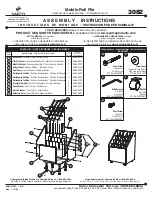
September
2017
Sentinel V SC and RT Operation Manual
Page 132
EAR-Controlled Technology Subject to Restrictions Contained on the Cover Page.
Removing Biofouling
To remove foreign matter and biofouling:
1. Remove soft-bodied marine growth or foreign matter with soapy water. Waterless hand cleaners
remove most petroleum-based fouling.
Do not use power scrubbers, abrasive cleansers, scouring pads, high-pressure marine cleaning
systems or brushes stiffer than hand cleaning brushes on the transducer faces. The urethane
coating on the transducer faces could be damaged.
If there is heavy fouling or marine growth, the transducer faces may need a thorough cleaning to
restore acoustic performance. Barnacles do not usually affect Sentinel V ADCP operation, but
TRDI does recommend removal of the barnacles to prevent water leakage through the transducer
face. Lime dissolving liquids such as Lime-Away
®
break down the shell-like parts. Scrubbing with
a medium stiffness brush usually removes the soft-bodied parts. Do NOT use a brush stiffer than a
hand cleaning brush. Scrubbing, alternated with soaking in Lime-Away
®
, effectively removes
large barnacles.
If barnacles have entered more than 1.0 to 1.5 mm (0.06 in.) into the transducer face
urethane, the Sentinel V ADCP should be sent to TRDI for repair. If barnacles cannot be
removed without damaging the transducer faces,
2. Thoroughly clean out any biofouling from the Touch sensor.
3. Rinse with fresh water to remove soap or Lime-Away
®
residue.
4. Dry the transducer faces with low-pressure compressed air or soft lint-free towels.
Always dry the Sentinel V ADCP before placing it in the storage case to avoid fungus or mold
growth. Do not store the ADCP in wet or damp locations.
Figure 69.
Biofouling on a Sentinel V ADCP
The pressure sensor cavity is not filled with oil when shipped. This must be done before
deploying the Sentinel V ADCP. The Pressure sensor cavity should be checked and if needed
refilled between deployments.
Notice how
most organisms did not
seem to find the copper surface of the
Pressure Sensor attractive.
















































